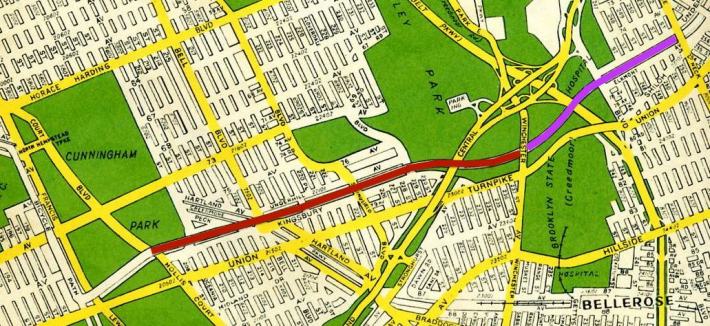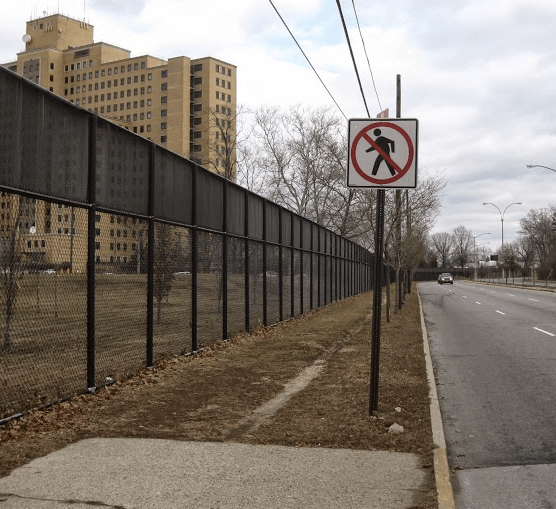
Union Turnpike, running 10 miles through the midsection of Queens and across the border to Nassau County, is one of the borough's most unsafe places to walk or bike. Now, a group of eastern Queens residents is looking to extend an existing walking and biking path through state- and city-owned property parallel to the multi-lane road.
Last year, Tri-State Transportation Campaign ranked Union Turnpike as the third-most dangerous road in Queens [PDF]. A particularly treacherous location is near the Cross Island Parkway, where sidewalks disappear and highway ramps take over. Earlier this month, a man was killed while walking in this area. He's not alone: Pedestrians were killed at this location in 2000 and 2009, according to data compiled by CrashStat.org.
A group of advocates is finding a solution in the Long Island Motor Parkway, built by William Kissam Vanderbilt II in the early 20th century but abandoned just a few decades later as the parallel Grand Central and Northern State parkways opened. In 2002, Vanderbilt's route was added to the state and national registers of historic places, and a section from Winchester Boulevard to Cunningham Park opened as a bike and pedestrian path.
Across the border, Nassau County hired consultants to prepare a vision plan for converting its section of the route into a shared-use path, but progress since the report was released in 2010 has been slow.
Joby Jacob, a professor who lives in Hollis Hills, has long dreamt of extending the existing Queens pathway east to the Nassau border. Now, he and fellow advocates in eastern Queens have launched an effort, named Motor Parkway East, to make the idea a reality.
The group has sketched out a concept of how a path could be built, at first using at-grade crossings and eventually adding more substantial investments like a new bridge over busy Winchester Boulevard as funds become available.

The route passes entirely through property managed by the state Office of Mental Health and the NYC parks and education departments, including Creedmoor Psychiatric Center, the Frank A. Padavan Educational Campus, Queens Children's Psychiatric Center and the Queens County Farm Museum. "There’s absolutely no eminent domain involved. There’s absolutely no inconvenience to a single neighbor," Jacob said. "This is about opening up something we already own to the people who own it."
With so many government agencies involved, Jacob is hoping to enlist the support of elected officials, and has already approached Council Member Mark Weprin. "The next step is really talking to some state government officials," Jacob said. "I am open to working with anybody on this project."
Update: "I think it would be a great idea," Weprin said of the Motor Parkway East proposal. "It is a hidden treasure and I’d like to have more people using it," he said of the former parkway route. Weprin added that in addition to meeting with advocates, he has started reaching out to elected officials, including Assembly Members Ed Braunstein and David Weprin. He plans to set up meetings with city and state agencies soon to discuss the project.
“We just need to look into the feasibility of extending it," Weprin said. "We’re dealing with a bureaucracy, and once you get bureaucracy involved it’s probably going to be more difficult than you had hoped."
The key to getting local groups and officials on board is the group's petition, which has already gathered more than 200 signatures. If it was just him, Jacob said, "You'd just one crazy guy talking. When you have 200 people signing your petition, it’s a little bit stronger."
By extending a bike and pedestrian path parallel to busy Union Turnpike, which has no sidewalks in much of this area, Jacob said he hopes residents of Glen Oaks, Oakland Gardens and Hollis Hills will feel safe getting around without a car. "I really want to do something in eastern Queens that helps people see that there’s more to transportation than either taking the bus or driving your car," Jacob said.





